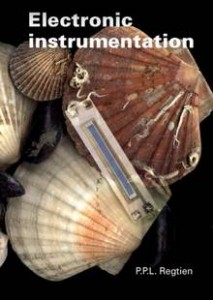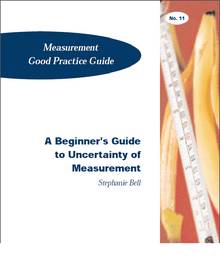Readings Measurement Science
Course week(s)
Week 1
Week 2
Week 3
Week 4
Week 5
Week 6
Week 7
Week 8
Course subject(s)
1. Introduction to Measurements and Measurement Systems
2. Sensors
3. Sensor Readout and Signal Conditioning
4. Instrumentation Amplifiers
5. Analog-to-Digital Convertors
6. Measurements Instruments I
7. Measurements Instruments II
8. Exam
9. Readings
The course Measurement Technology uses the following Readings;
- Electronic Instrumentation By P.P.L. Regtien, 2005 VSSD Delft.
- A beginner’s guide to uncertainty in Measurement By S.A. Bell, August 1999 National Physical Laboratory Teddington, Middlesex.
Electronic Instrumentation
 Reference: P.P.L. Regtien (2005), Electronic Instrumentation. VSSD Delft. ISBN 9789065622143
Reference: P.P.L. Regtien (2005), Electronic Instrumentation. VSSD Delft. ISBN 9789065622143
Electronic systems have made deep inroads into every aspect of daily life. One need only look around homes, offices and industrial plants to see that they feature almost everywhere. Indeed, it is practically impossible to name any appliances, tools or instruments that do not contain electronic components. In order to compete with rival companies or just remain a step ahead of them, the designers of technical systems and innovative products must be fully aware of both the assets and the limitations of electronic components and systems. Users of electronic systems also need to have a basic knowledge of electronic principles. In order to fully exploit an instrument’s potential, to be aware of its limitations, to correctly interpret the measurement results and to be able to arrive at well-balanced decisions relating to the purchasing, repairing, expansion or replacement of electronic equipment, all users of such systems also need to have a basic knowledge of electronic principles.This book offers such basic knowledge and provides guidance on how to obtain the relevant skills. The kinds of topics dealt with are operating principles, the performance of analog and digital components and circuits, and the precise characteristics of electronic measuring systems. Throughout the book, every endeavor is made to impart a critical attitude to the way in which such instruments should be implemented. The book is based on various series of courses on electronics and electronic instrumentation that were given by the author during the many years when he lectured at Delft University of Technology in the Netherlands. The courses were designed for students from various departments such as: Mechanical Engineering, Aeronautical Engineering and Mining Engineering. When numbers of non-Dutch-speaking Master of Science students started to rise it became necessary to publish an English version of the book. The particular way in which the book has been organized makes it suitable for a much wider readership. To meet the demands of divergent groups it has been structured in a modular fashion. Each chapter discusses just one particular topic and is divided into two parts: the first part provides the basic principles while more specific information is given in the second part. Each chapter ends with a summary and several exercises. Answers to all the exercises are given at the back of the book. This approach is conducive to self-study and to the composition of tailor-made course programs.
Preface:
1. Measurement systems – 2. Signals – 3. Networks – 4. Mathematical tools – 5. Models – 6. Frequency diagrams – 7. Passive electronic components – 8. Passive filters – 9. PN diodes – 10. Bipolar transistors – 11. Fieldeffect transistors – 12. Operational amplifiers – 13. Frequency-selective transfer functions with operational amplifiers – 14. Non-linear signal processing with operational amplifiers – 15. Electronic switching circuits – 16. Signal generation – 17. Modulation – 18. Digital-to-analogue and analogue-to-digital conversion – 19. Digital electronics – 20. Measurement instruments – 21. Measurement errors
A beginner’s guide to uncertainty in measurement
 Reference: Stephanie Bell (2001), A beginner’s guide to uncertainty in measurement. Teddington, Middlesex, United Kingdom. ISSN 1368-6550.
Reference: Stephanie Bell (2001), A beginner’s guide to uncertainty in measurement. Teddington, Middlesex, United Kingdom. ISSN 1368-6550.
The aim of this Beginner’s Guide is to introduce the subject of measurement
uncertainty. Every measurement is subject to some uncertainty. A measurement result is only
complete if it is accompanied by a statement of the uncertainty in the measurement.
Measurement uncertainties can come from the measuring instrument, from the item being
measured, from the environment, from the operator, and from other sources. Such uncertainties
can be estimated using statistical analysis of a set of measurements, and using other kinds of
information about the measurement process. There are established rules for how to calculate an
overall estimate of uncertainty from these individual pieces of information. The use of good
practice – such as traceable calibration, careful calculation, good record keeping, and checking –
can reduce measurement uncertainties. When the uncertainty in a measurement is evaluated and
stated, the fitness for purpose of the measurement can be properly judged.

Measurement Science by TU Delft OpenCourseWare is licensed under a Creative Commons Attribution-NonCommercial-ShareAlike 4.0 International License.
Based on a work at https://ocw.tudelft.nl/courses/measurement-science/.



